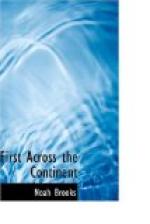Two days later they were high up among the mountains, although the ascent was not very steep. At that height they found the weather very cool, so much so that on the morning of the sixth of July, after a cold night, they had a heavy white frost on the ground. Setting out on that day, Captain Clark crossed a ridge which proved to be the dividing line between the Pacific and the Atlantic watershed. At the same time he passed from what is now Missoula County, Montana, into the present county of Beaver Head, in that State. “Beaver Head,” the reader will recollect, comes from a natural elevation in that region resembling the head of a beaver. These points will serve to fix in one’s mind the route of the first exploring party that ever ventured into those wilds; descending the ridge on its eastern slope, the explorers struck Glade Creek, one of the sources of the stream then named Wisdom River, a branch of the Jefferson; and the Jefferson is one of the tributaries of the mighty Missouri. Next day the journal has this entry:—
“In the morning our horses were so much scattered that, although we sent out hunters in every direction to range the country for six or eight miles, nine of them could not be recovered. They were the most valuable of all our horses, and so much attached to some of their companions that it was difficult to separate them in the daytime. We therefore presumed that they must have been stolen by some roving Indians; and accordingly left a party of five men to continue the pursuit, while the rest went on to




